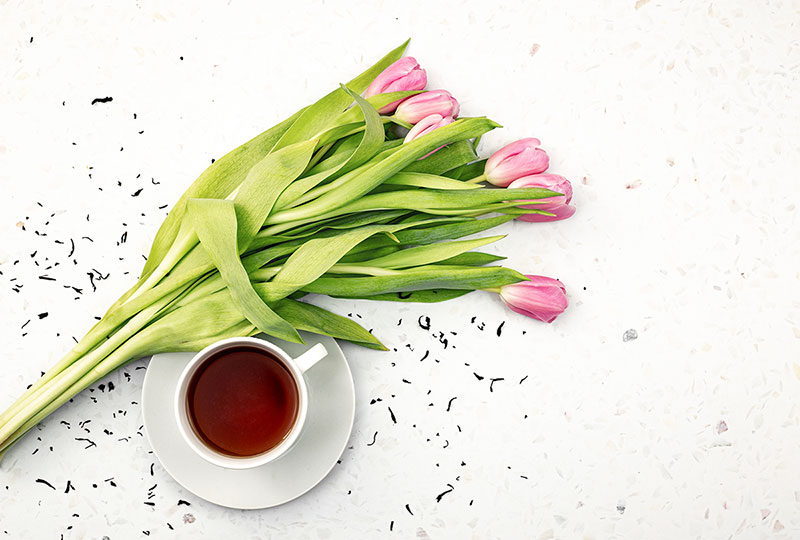Best Teas for Energy Boost
Looking for the best teas for energy boost to replace energy drinks? Not sure which teas to choose? Not all teas are grown or made the same. Some may provide more energy than others. Find out which teas contain the most caffeine.
Does tea provide energy?
All real teas contain caffeine. Caffeine is found in 60 different plants[1]. The most common source of caffeine are coffee beans and teas made from camellia sinensis plant. Other significant sources are guarana seeds, mostly used for making energizing drinks, powders or pills, yaupon leaves used for making tea, kola nut and cacao pods, and a popular South American plant yerba mate.
Although caffeine may provide several health benefits, the main reason why it gained so much popularity is the almost instant energy boost it may provide. Caffeine is a central nervous system stimulant that may make you feel more awake[2] and energized even when you feel very tired. Caffeine from different sources may have a slightly different effect on your body, but it will always provide at least light energy boost. For example, when drinking green tea, you will not only be ingesting caffeine, but other compounds too. One of them, L-theanine, may provide a calming effect. That’s why green tea, compared to coffee, is less likely to cause the jitters, while providing energy, increasing focus and calmness.
Although caffeine is considered the primary source of energy in tea, there are other ways tea could help. For example, a proper healthy sleep may increase energy levels during the day. That means that having too much caffeinated drinks may actually cause the lack of energy. Interestingly, that’s exactly why herbal teas that are 100% caffeine free, but provide calming and relaxing effect may have a positive effect on energy levels too. While helping you relax and sleep, they indirectly benefit your overall wellbeing causing a rise in energy too.
What tea is highest in caffeine?
The amount of caffeine in tea depends on many factors, starting from a tea plant. There are different tea varieties and cultivars, and each of them may have different levels of caffeine. Next, the amount of caffeine will depend on the growing conditions. For example, shading tea plants may increase the levels of caffeine.
How the tea is harvested and processed will impact the levels of caffeine in your cup as well. For example, older more mature leaves will have less caffeine than younger leaves closer to the bud. Teas that contain stalks and stems or are made only from stalks and stems such as kukicha will have much less caffeine. Some teas are aged or roasted, and both may decrease the caffeine levels. Smaller broken leaves will be able to release more caffeine than unbroken leaves. Different types of tea will have different levels of caffeine as well.
And lastly, water temperature, the amount of leaves you are using and steeping time will impact the final content of caffeine in your cup of tea.
If you want teas with the most caffeine, you may want to choose:
- Teas with smaller broken leaves
- Teas made from Assamica variety tend to have more caffeine
- Shaded green teas
- Teas from spring harvest
Another way to increase the caffeine content in your cup is to use hotter water and more tea leaves and steep them longer.
Best Teas for Energy Boost
1. Black Tea
Black tea is often described as tea type with the most caffeine. However, not all black tea contains the same amounts of caffeine. Studies show that broken Assam tea leaves or even Assam tea dust may contain even up to 3 times more caffeine than Assam full tea leaf – 3 grams per 100 grams of dry leaves[3]. However, dust will offer superior flavor too.
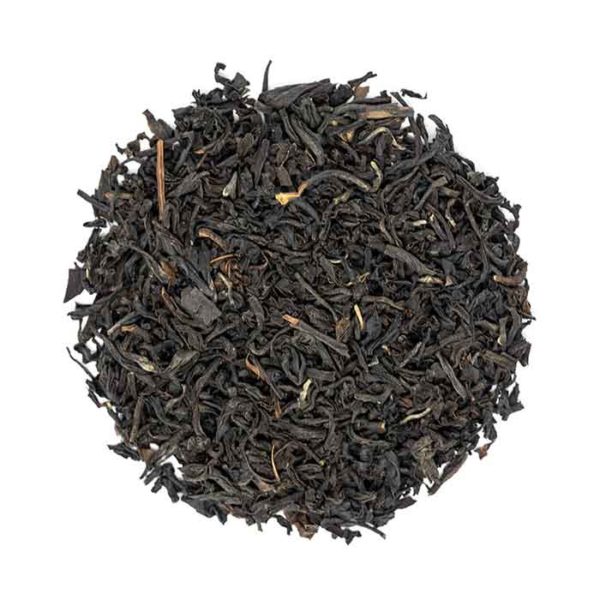
Organic Assam orthodox black tea
2. Green Tea
Green tea may contain high levels of caffeine. In fact, some green teas may provide much more energy than many back teas. Shaded Japanese green teas usually contain more caffeine than unshaded teas. Gyokuro, a type of shaded Japanese tea may give a very strong energy boost. Other popular shaded tea is matcha. A bowl of matcha green tea made with 2 grams of tea powder will provide approximately 60 mg of caffeine. Interestingly, the amount of caffeine in matcha tea powder is almost the same as the amount of caffeine in Assam tea dust from the study mentioned above.
Green tea made from Assamica tea plant may also contain higher levels of caffeine. Chinese green teas from Yunnan or Vietnamese green teas may have a slightly higher amount of caffeine[4].
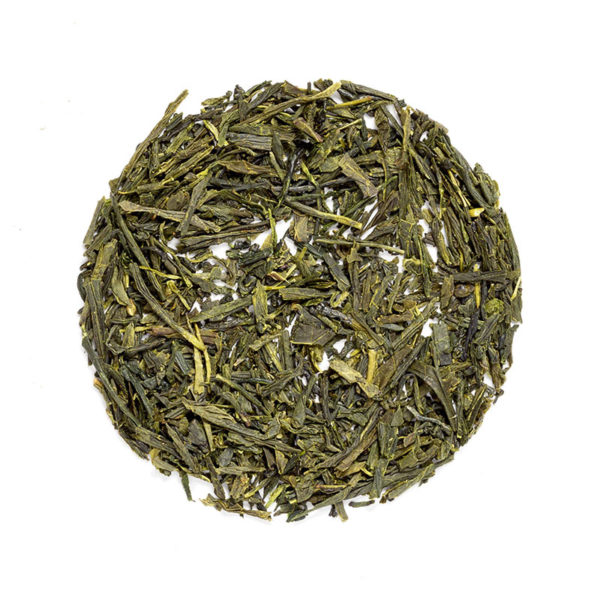
Japanese sencha green tea
3. White Tea
Even though white tea is often described as gentle and low on caffeine, this is not always the case. White tea may have a gentler and more delicate flavor, but is likely to contain more caffeine than many black or green teas. For example, studies showed that Pai Mu Tan has around 18 mg of caffeine per gram of dry leaf[5]. This is more than 11 mg per gram of dry Assam whole leaf tea[6].
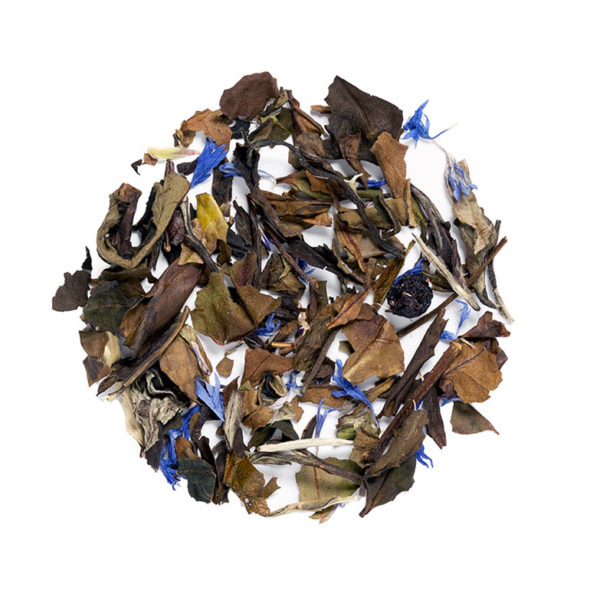
Simple Blueberry White blend with shou mei tea
4. Oolong tea
Oolong tea is a type of semi-oxidized tea, falling between green and black tea type. Some oolong teas may contain high levels of caffeine. Oolong tea is usually prepared using more tea leaves – sometimes even 10 grams, using hotter water. Unroasted oolong tea, or tea containing lots of younger leaves will have more caffeine.
5. Pu’erh tea
Pu’erh is a type of dark fermented tea from Chinese Yunnan province. There are many types of pu erh tea, and each of them will have a different amount of caffeine. Pu’erh is one of those teas that may actually cause tea drunkenness. Tea drunkenness is usually caused by caffeine and other compounds in tea. Pu’erh is prepared in smaller tea pots, and re-steeped many times, sometimes even more than 15. Studies showed that fermented pu’erh will have a much higher levels of caffeine than non-fermented pu’erh tea, and even much higher than most black teas[7].
Read more: 10 high-caffeine loose leaf teas.
6. Yerba Mate Tea
Yerba mate or Ilex paraguariensis is a plant native to South America, used for making caffeinated tea. Depending on which type of mate tea is used for making tea, and the way it’s prepared, yerba mate drink may have more caffeine than a regular cup of coffee – even up to 135 mg[8]. However, some yerba mate drinks may have a very low leaves of caffeine, especially when prepared western style using roasted leaves.
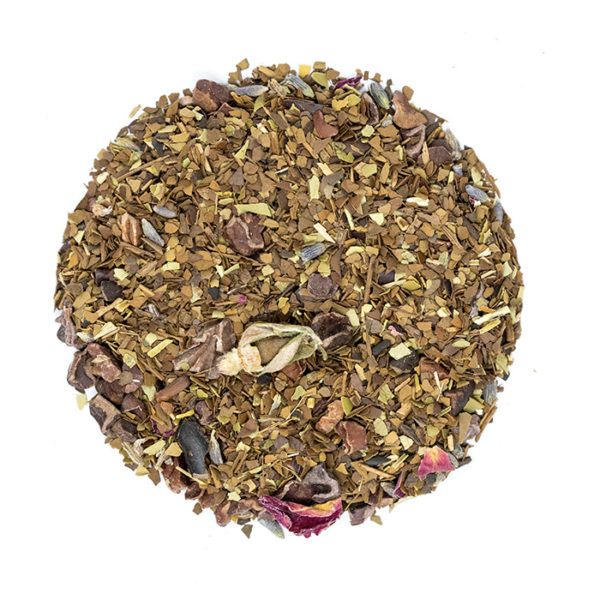
#9 Mate herbal tea blended wtih roasted and green yerba mate, cacao nibs, lavender and rose petals
7. Other Herbal teas
Some herbal teas may provide an energizing effect too. Some of them, peppermint tea, ginger tea and lemongrass tea are widely available and easy to make. Check out the top 15 caffeine free teas for morning energy boost here.
Disclaimer: This article is for informational purposes only. It’s not intended to replace medical advice, diagnosis or treatment. Every person is different and may react to different herbs and teas differently. Never use teas or herbs to treat serious medical conditions on your own. Always seek professional medical advice before choosing home remedies.
References:
[1] https://www.news-medical.net/health/Caffeine-Occurrence.aspx
[2] https://medlineplus.gov/caffeine.html
[3] https://www.ncbi.nlm.nih.gov/pmc/articles/PMC5380613/
[4] https://www.ncbi.nlm.nih.gov/pmc/articles/PMC4787341/
[5] https://www.ncbi.nlm.nih.gov/pmc/articles/PMC4787341/
[6] https://www.ncbi.nlm.nih.gov/pmc/articles/PMC5380613/
[7] https://www.researchgate.net/publication/262420912_Absorption_of_caffeine_in_fermented_Pu-er_tea_is_inhibited_in_mice
[8] http://www.latamjpharm.org/trabajos/24/1/LAJOP_24_1_2_5_8KBZFG0I38.pdf



